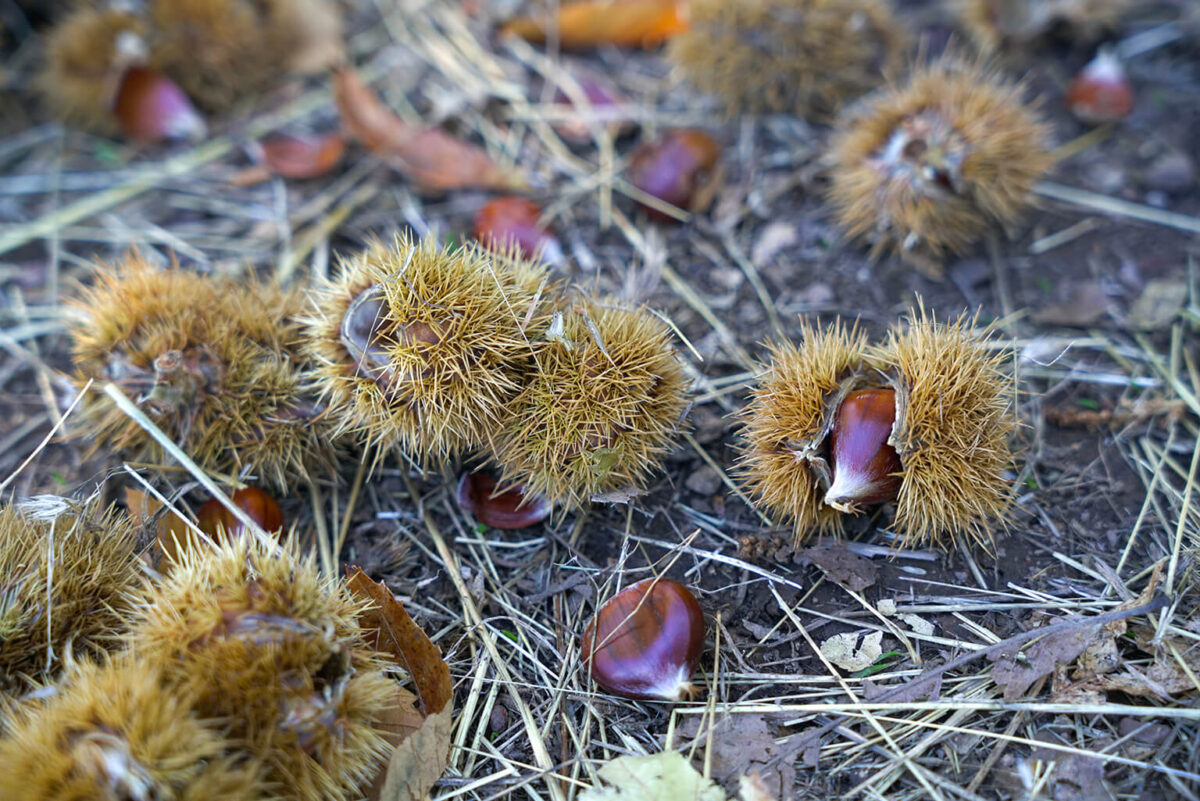Words by Johanna Harlow
Sometimes a prickly exterior can hide something precious. That’s certainly true of the fearsome-looking chestnut. As I navigate the 20-acre U-pick orchard in the hills of La Honda, the ground is littered with small, spiky balls that resemble wayward sea urchins. Emboldened by the thick work gloves protecting my hands, I scoop one up. Upon closer inspection, the rich, glossy sheen of the nut is peeking through a crack in the husk like a precious gem.
“They’re going to be sweeter than anything you can get in the store,” Hans Johsens tells me. At 6-foot-3, Hans is a sturdy fellow with a lumberjack’s physique—ironic considering that his role here is cultivating rather than cutting down the 113 trees at Skyline Chestnuts. He acts as caretaker, partnering with Midpeninsula Regional Open Space District, which owns the land. Every fall, thousands flock to this orchard to gather the precious nuts. “I tell people that I don’t sell chestnuts, I sell an experience,” he says. “Most of the people that come here will say it’s one of their favorite things to do all year!”
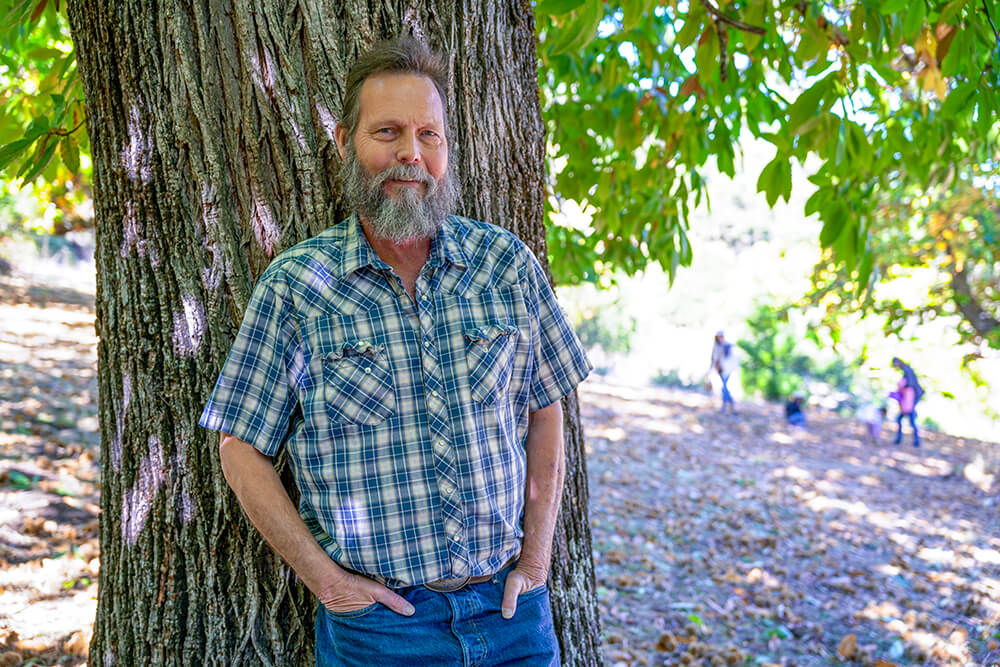
Portrait Photo & Cover Photo: Johanna Harlow
The Man of the Orchard
“I’ve always had a strong interest in plants and growing things,” Hans says, tugging off his own gloves to reveal palms weathered from a lifetime of working with his hands. Before taking over the orchard, Hans worked as a mechanic, then as a Christmas tree farmer, selling Douglas firs, sequoias and Scotch pines while expanding his understanding of agriculture.
I certainly see the appeal of the La Honda hills. To get here, I drove a long winding road mostly flanked by evergreens—the occasional bigleaf maple adding bright splashes of yellow like leafy fireworks.
Hans’ passion for plants was fostered by a childhood spent amid old-growth forests in the Santa Cruz Mountains with his green-thumbed father. “He worked at a nursery when he was in high school,” Hans says of his dad, “and he’d always dreamed of starting a nursery.” He recounts fond memories of frequent family road trips across California, including annual summer stops at apple farms in Mendocino. “Most of the trips that I went on with my dad and my brother and sisters were agriculture-oriented in some way.”
Years later, Hans came to check out the chestnut orchard. “I fell in love,” he recalls. For anyone who’s visited Skyline Chestnuts, it’s no mystery. “The whole orchard is in a half-bowl. You can walk up to the top of the ridge and see all the way out to the ocean,” Hans describes. “Sometimes you’ll see the fog come just piling up over the top of the ridge up there.”
Hans opened up the orchard to U-pick visitors in 2004. But at the beginning, the going was slow. “I wouldn’t even get 10 customers in a day,” says Hans. He plunged right in, clearing out the overgrowth and dead wood clogging the trees. “You could really only access about 10 percent of the crop,” he recollects. “Over the next five years, I would take whatever I made here and put it back into the orchard, clearing the brush underneath the trees, making sure the branches were cleaned up and pruned.” Slowly, a thriving orchard emerged.
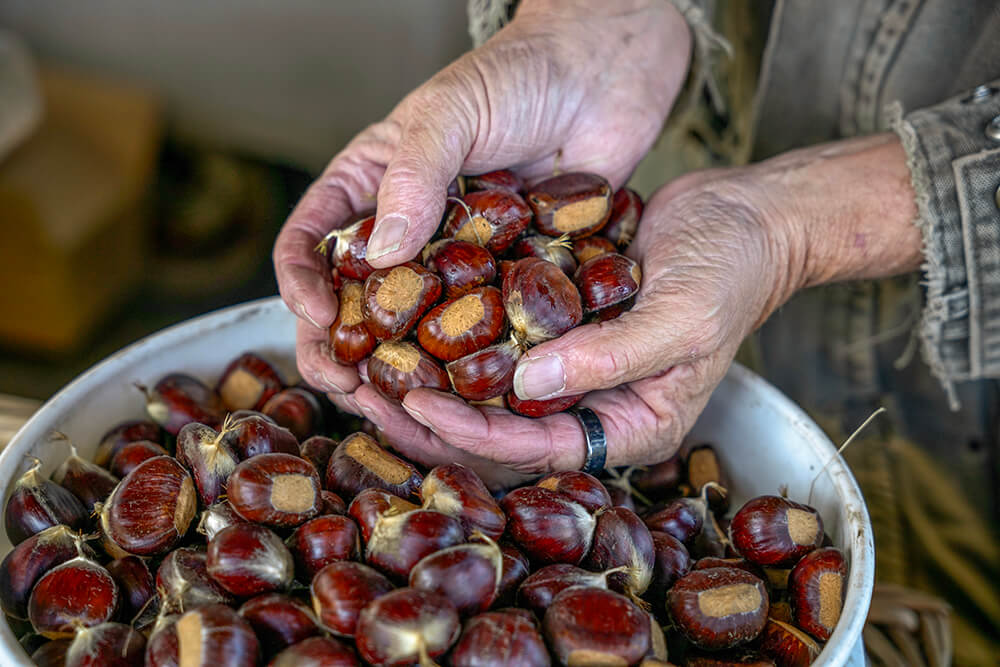
Photo: Johanna Harlow
The Chestnut Bandits
The underbrush was not the only adversary Hans confronted.
Before Hans took over as caretaker, the open space district allowed people to gather chestnuts for free. Some didn’t take kindly to its conversion to a U-pick that charges by the pound. In the dead of night, “people started harvesting them with flashlights,” Hans recalls.
For the first several years, Hans had to lay down the law to earn respect. “I had my dirt bike and I’d go chasing them down the trail,” he relays. The open space district’s rangers supported Hans, alerting him when they found cars parked down the road.
Other chestnut bandits tried to distract Hans by paying for small quantities while smuggling out the majority of their bounty in backpacks or pockets. But nothing gets past Hans. “Early on, I’d have two prices. I’d say it’s $5 a pound for what you want to buy, $20 a pound for what you want to steal.” On more than one occasion, someone had to leave a pal behind as collateral while they went to withdraw cash for their ill-gotten gains. “I don’t have that problem today, though,” Hans notes. “I don’t back down for anybody.”
A protective papa bear when it comes to his trees, Hans also has a strict policy on gathering nuts from the ground only. “I’ve seen visitors use ropes with grappling hooks, throwing them up in the trees and pulling branches down, whole branches,” he says, appalled. “Or they use big sticks to beat them out of the trees.”
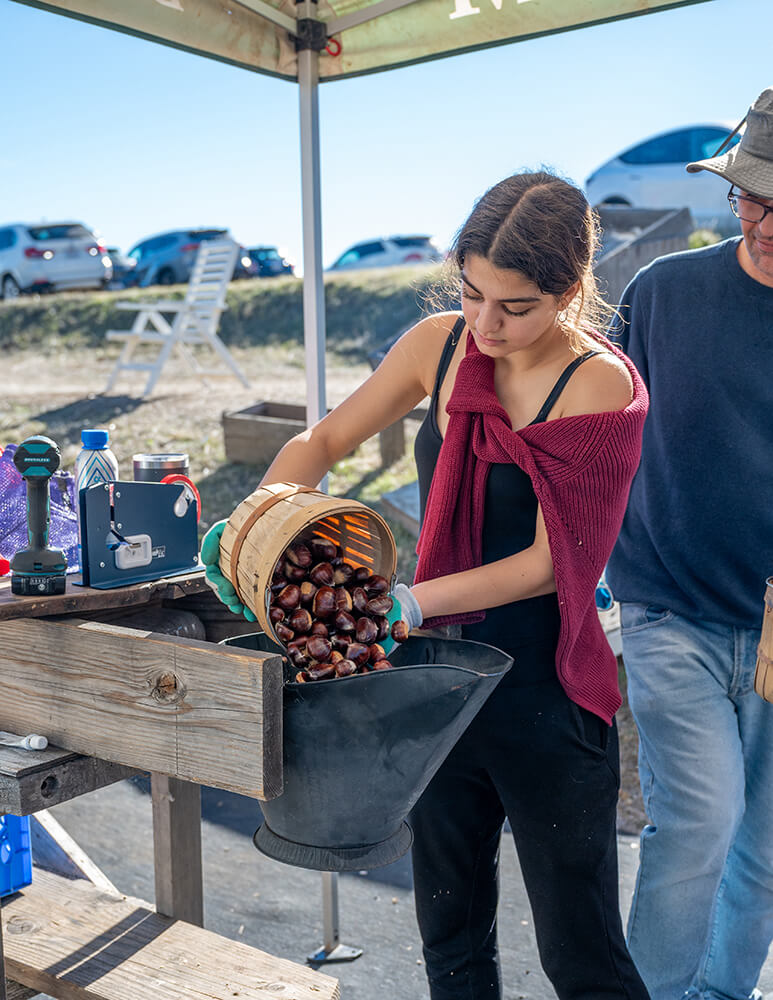
Photo: Robb Most
Good Encounters
Of course, the good encounters outweigh the bad. “My favorite memories are of the customers I meet,” shares Hans, adding that they sometimes bring gifts. “I had a customer bring chestnut ravioli with chanterelle mushrooms as the filling. That was fantastic.” He’s also been the beneficiary of chocolate chestnut cake and chestnut chicken soup, a traditional New Year’s meal in parts of Asia.
Chestnut trees aren’t native to California. The ones at Skyline Chestnuts, which include varieties from Europe, China, Japan and America, were brought over by Gold Rush hopefuls. People who hail from the East Coast, Europe and Asia are much more familiar with the tree and come to Skyline for a taste of home. One of Hans’ loyal customers hails all the way from Japan, visiting during her autumn trips to see relatives in San Francisco. “She always planned it around chestnut harvest so that she could come here,” says Hans.
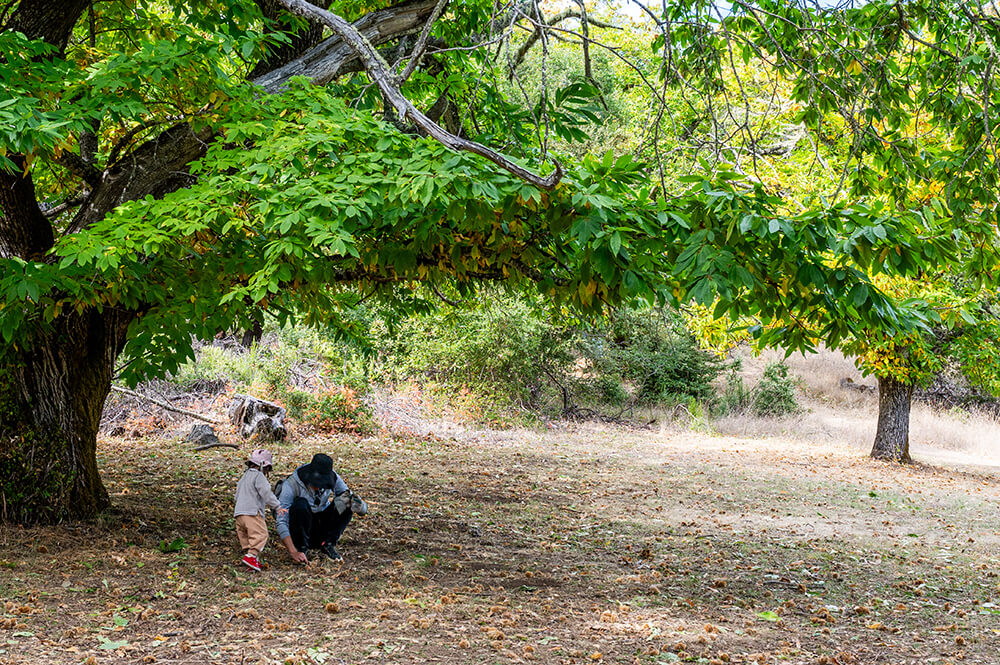
Photo: Robb Most
that’s history
Of the orchard visitors who live in the States, Hans estimates that more than half come from the East Coast, where this special tree once grew in abundance. “The chestnut trees were so numerous that it was said that a squirrel could travel from Maine to the Gulf Coast, branch to branch, without touching the ground,” Hans marvels. “They were known as the redwoods of the East.”
Not anymore. “In the early 1900s, the American chestnut was starting to get wiped out by a disease that was imported to the Bronx Zoo,” Hans says. The blight swept the East Coast, taking 4 billion American chestnut trees with it, and reducing its numbers to a few untouched spots in Michigan, Wisconsin and the West Coast. Four of Hans’ trees are American. “The chestnuts that come off of those are smaller. They’re sweeter.”
At Skyline Chestnuts, both the trees and the business are thriving. In fact, the pandemic brought in such throngs of stir-crazy folks that Hans implemented an online reservation system. “People were really eager to get out of the house,” he says. “The entire parking lot was completely blocked up with cars—15 minutes after we opened the gates.” People parked miles away and hiked in. “It was nuts!” Lately, Hans sees about 500 people a day. “You make a reservation for the space that you park in,” he explains. “You can have as many people as you can pack into your car.”
Not all of Hans’s visitors are human. “I do lose some chestnuts to the wildlife,” he admits. It seems that wild turkeys, deer, squirrels and the endangered dusky-footed woodrat also enjoy feasting on chestnuts. Even so, he estimates he sells about two-and-a-half tons per season.
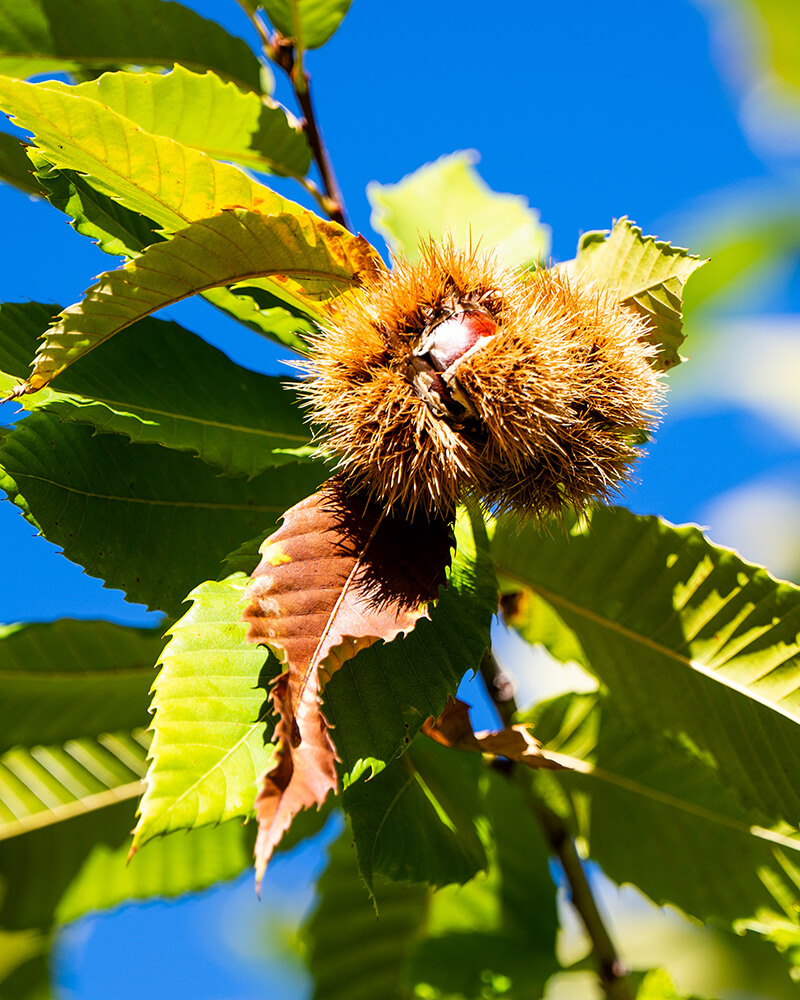
Photo: Robb Most
Nuts About Nuts
The part of his job Hans loves the most? “The freedom of it,” he says without hesitation. “You can barely make a living, but it’s a great life. I have the rest of the year to do what I would like to do.” And what exactly does he do with the rest of his time? “Surprisingly, it’s talk a lot about chestnuts,” Hans laughs. Since becoming a bit of an expert over the years, Hans could be off doing some on-site consulting for a permaculture farm in Half Moon Bay or giving guidance on planting chestnut trees to the retired head of the New York City Transportation Department.
But come mid-October, you’ll find Hans and Chewy (his elderly chihuahua) welcoming guests to the orchard. “I’ve really come to know these trees,” Hans says, taking a moment to survey his little patch of paradise.
Everywhere, people with baskets on their arms engage in an autumnal Easter egg hunt. Farther off, a flock of turkeys are on a similar mission, scratching through the leaves for the precious nuts. “The setting couldn’t be better,” Hans decides. “I have the best office in the world.”
So you’ve harvested your chestnuts… Now what do you do with them? The nuts can be ground into flour for pasta or baked goods, Hans explains, but my “favorite way is just roasting them over the fire. I’ll bring a 20- or 30-pound bag of chestnuts, a couple of roasting pans and a handful of chestnut knives to a party.” It’s always a hit.


